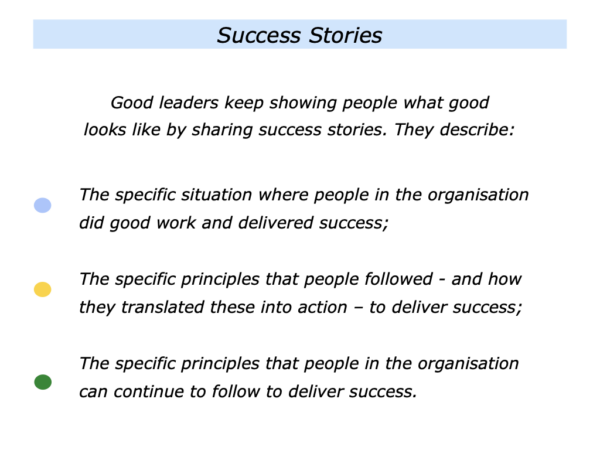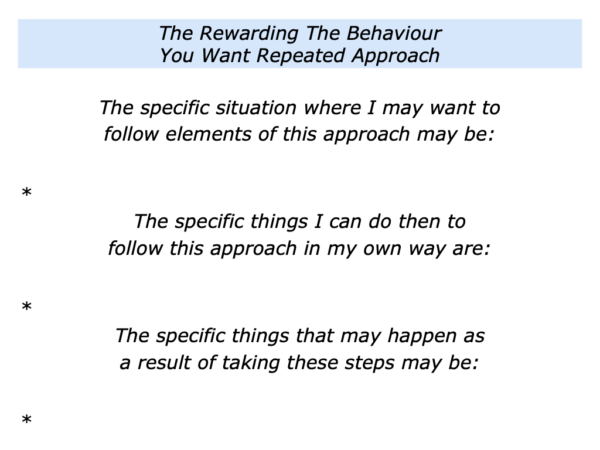
There are many ways to build successful cultures. One approach is to reward the behaviour you want repeated. This is a principle that applies when encouraging people in a team, organisation or the wider society.
Imagine that you have been given the mandate to lead an organisation that aims to shift its culture and achieve success.
You may want to communicate the guidelines that people can follow to reach the goals. These need to be specific rather than woolly statements. It is also useful to outline the reasons for following these guidelines.
Good leaders recognise that the carrot is mightier than the stick as a means of encouraging people to achieve peak performance.
Such leaders also act quickly, however, if some people choose not to opt in. So after communicating the guidelines:
They reward the behaviour the organisation wants repeated;
They act decisively regarding behaviour the organisation does not want repeated;
They do whatever is required to guide the organisation to success.
Imagine that you are aiming to encourage people to follow certain guidelines. You may want to consider taking some of the following steps.
You can communicate the behaviour
people can demonstrate the help the
the organisation to achieve success
Good leaders give clear messages about how they expect people to behave. They also give the reasons for these professional standards. Such leaders often start by taking the following steps:
They clarify the behaviour that people need to demonstrate to help the organisation to achieve success;
They clarify the reasons why it is important for people to follow these guidelines.
People are more likely to opt in if they see the reasons for behaving in certain ways. Some people may choose not to opt in, of course, but that will produce consequences.
Good leaders outline the guidelines – The Dos – that people can follow to reach the goal. For example, it may be important for people to do the following things:
To have a positive attitude and take responsibility;
To make clear working contracts about their contributions towards achieving the organisation’s goals;
To perform superb work, find solutions to challenges and encourage other people;
To keep others up-to-date with how they are progressing towards achieving the goals;
To do whatever is required to ensure the organisation reaches its goals.
The Don’ts will probably be the reverse side of these behaviours.
Let’s assume you are clear on the guidelines you would like people to follow. You can then aim to do three things.
To be a positive model – because people learn from what you do not what you say;
To communicate the guidelines that people can follow to help the organisation to achieve success;
To explain the reasons why it is important for people to follow these guidelines;
Imagine you are a leader who wants to set the tone in an organisation. Try completing the following exercise.
Building A Successful Organisation
The Dos – the guidelines – we want people follow to
help the organisation to achieve success are these:
*
*
*
*
*
The reasons why we would like
people to follow these guidelines are:
*
*
*
*
*
You can continue to reward the
behaviour you want repeated
Different people encourage others in different ways. You may see somebody doing something well, for example, and have a special word with the person.
Be super specific about the behaviour – or the principles – you want them to repeat. The more specific you are, the more likely people are to repeat the behaviour.
One soccer manager spent time with one of his attackers at half time, for example, and described the specific things the player was doing well. He said:
“The way you beat their full back three times in the first half was excellent. You dummied to move inside, but then changed direction to go down the right wing and put in dangerous crosses.
“I want you to keep doing that in the second half. It’s up to you how you beat the full back. But I want you to get to the by-line and put in as many crosses as possible.”
The manager then checked with the player: a) if he had understood the message; b) if it was something he was happy to do. The manager then encouraged the player to keep doing their best.
You can keep sharing success stories
It is vital to keep showing people what good looks like. People can then aim to follow these principles to achieve success.
Different organisations use different frameworks for publicising such stories. Here is one approach.

You can deal with the behaviour
you don’t want repeated
How to act when somebody steps over the line? Here are some options.
You can give the person a positive alternative
One approach is to say, for example:
“In the future can you please do (x) rather than (y). The reason is because …”
This gives the person a possible positive way forwards. It is up to them which route they want to tak.
You can act immediately
and practice zero tolerance
Some leaders feel it is vital to do this if a person’s behaviour contravenes a team’s agreed rules. It is important to never walk past a quality problem, otherwise the leader has said that such behaviour is okay.
You can give the person a warning, outline the consequences
of repeating the behaviour and be prepared to follow-through
Many leaders believe that it is moral to give the person another chance. The key is to make sure the person knows that the leader is serious.
Some behaviour can lead to instant dismissal. On other occasions it is more appropriate to outline the professional standards that are required.
Good leaders then follow through. If the person does not meet the professional standards, then they are choosing to move on.
“Reward the behaviour you want repeated,” may sound an over-simple philosophy, but it works in many situations. People soon get the message about the desired culture and ‘the way we will do things round here’.
Let’s return to your own life and work. Looking ahead, can you think of a situation where you may want to follow elements of this approach? How can you do this in your own way?
If you wish, try tackling the exercise on this theme. This invites you to complete the following sentences.







Leave a Reply